A new genus, Tenguobythus, and five new species of the Iniocyphine subtribe Natypleurina from Japan (Coleoptera, Staphylinidae, Pselaphinae)
Abstract
A new pselaphine genus, Tenguobythus, is defined with descriptions of five new species: T. nasalis from Honshû, Miyake-jima Island, Shikoku and Kyûshû, T. rhinoceros from Amami-Ôshima Island, T. pentagonus and T. yama from Okinawa-jima Island and T. decoratus from the Yaeyama Islands.
INTRODUCTION
The subtribe Natypleurina belongs to the tribe Iniocyphini of the supertribe Goniaceritae. This subtribe is known to include 31 genera from around the world (Chandler 2001). Four genera, Morana Sharp, Nipponobythus Jeannel, Takaorites Jeannel, and Brunomanseria Löbl and Kurbatov are currently known from the eastern part of Asia, and form a distinctive group (Löbl & Kurbatov 2004).
In the present paper, we describe the genus Tenguobythus on the basis of the new type species, T. nasalis, collected from the mainland of Japan and an associated island (Honshû, Miyake-jima Island, Shikoku and Kyûshû), together with four new species occurring in the Ryûkyûs: T. rhinoceros from Amami-Ôshima Island, T. pentagonus and T. yama from Okinawa-jima Island, and T. decoratus from the Yaeyama Islands.
MATERIALS AND METHODS
The abbreviations used for the type depositories and body regions used herein are as follows: BL, body length; BW, body width; EU, Entomological Laboratory, College of Agriculture, Ehime University; HU, Systematic Entomology, Faculty of Agriculture, Hokkaido University; KPM, Kanagawa Prefectural Museum of Natural History; NSMT, National Science Museum, Tokyo; OMNH, Osaka Museum of Natural History; OPU, Entomological Laboratory, Osaka Prefecture University, Sakai; TUA, Entomological Laboratory, Faculty of Agriculture, Tokyo University of Agriculture, Atsugi, Kanagawa Prefecture. The abbreviations of collectors' names used herein are as follows: A. I., Atsuo Izumi; E. Y., Eiji Yamamoto; H. M., Hiroki Mizushima; H. O., Hisashi Ôishi; H. S., Hiroshi Sugaya; I. O., Iwao Okamoto; K. N., Katsuyuki Nakata; K. T., Koji Toyoda (present name Arai); N. A., Shun-ichiro Naomi; S. A., Shiho Arai; S. N., Shûhei Nomura; S. T., Shingo Tanaka; T. K., Toshio Kishimoto; T. S., Takashi Shimada; Y. S., Yoshihiro Sawada.
External morphological characters of specimens were observed with a binocular stereoscopic microscope (LEICA; MZ9 up to 60×, Leica Microsystems, Wetzlar, Germany). The microstructures of several important characters were examined by scanning electron microscope (SEM; XL 30CP; Royal Philips Electrics, Kobenharn, Danmark and JSM-6380LV; Japan Electron Optics Laboratory Co., Tokyo, Japan). All SEM materials were coated with platinum. Most specimens examined were extracted from soil by Tullgren funnels and hand sifting methods. Tergites and sternites of abdomen are referred to by their morphological rather than visible numbers.
SYSTEMATICS
Genus Tenguobythus nov.
(Japanese name: Tengu-arizukamushi Zoku)
Type species: Tenguobythus nasalis sp. nov.
Body small, BL 1.3–1.62 mm, BW 0.57–0.72 mm in male, 1.34–1.67 mm, BW 0.59–0.70 mm in female; weakly flattened on dorsal side; color dark reddish-brown, tarsi and palpi light brown. Head and pronotum narrow, elytra and abdomen broad.
Pronotum smooth, shiny on dorsal surface, slightly wider than long, sparsely covered with pubescence, with three transverse foveae at basal one-third. Elytra shiny, wider than long, sparsely covered with pubescence, each elytron with two basal foveae. Hindwings well developed in male, lacking in female. Legs short, densely covered with pubescence; each femur swollen medially; each tibia gently curved; tarsal claws asymmetrical, anterior one much broader than posterior one.
Abdomen flattened on dorsal surface; 4th tergite largest, twice as wide as long, almost as long as 5th to 8th combined, with a pair of basal carinae and a shallow basimedian depression between them; 5th to 8th successively shortened posteriad; 8th tergite U-shaped, symmetrical and flat; 8th sternite E-shaped, median stalk long and slender; 9th tergite consisting of a pair of elongate sclerites each weakly sclerotized, broad in apical part, narrowed basally.
Male genitalia oblong in dorsal view; parameres asymmetrical at apical part, short; basal bulb of median lobe weakly sclerotized, rounded at basal part, basal foramen transverse, located between parameres; endophallus composed of a transverse apical sclerite, a few subconical middle sclerites, a few small basal sclerites and a group of minute spinules.
Female genitalia entirely membranous.
Remarks. This genus is similar to the genus Takaorites and NipponobythusJeannel (1958) in having a pair of setiferous patches on the male frons. However, it differs in the following characters: body size is smaller than in Takaorites and Nipponobythus; clypeus with narrow subfrontal cavity in Tenguobythus, lacking in Takaorites and Nipponobythus; frontal horn long in Tenguobythus, absent in Takaorites and Nipponobythus; pronotum with three transverse foveae in Tenguobythus, with an almost straight sulcus in Nipponobythus; median lobe of male genitalia with a group of large group of spinules in Tenguobythus, lacking in Takaorites and Nipponobythus. MoranaSharp (1874) and Tenguobythus both have a subfrontal cavity between the clypeus and frons. However, the former differs in the following characters: antennal tubercles projected anterodorsally in Morana, weakly projected, each with setiferous patches in Tenguobythus. Tenguobythus is separated from Brunomanseria (Löbl & Kurbatov 2004) by the following characters: elytron with a broad, shallow longitudinal sulcus margined by two carinae in Brunomanseria, simple and smooth in Tenguobythus.
Etymology. The new generic name is formed from a Japanese noun, “Tengu” and a related genus name, “-bythus.”“Tengu” means a big-nosed monster in Japanese folktales. The member of this genus has a strongly projecting frontal horn like a big nose.
Key to the males of species in the genus Tenguobythus
- 1
Frontal horn longer than one-half length of clypeus; clypeus weakly expanded anteriad, almost invisible in dorsal view. T. pentagonus sp. nov.
- –
Frontal horn shorter than one-half length of clypeus; clypeus strongly expanded and exposed in dorsal view. 2
- 2
Frontal horn scarcely extending anteriad, consisting of a pair of dorsal projections, strongly concave between dorsal projections. T. yama sp. nov.
- –
Frontal horn extending anteriorly, longer than one-third length of clypeus, almost flat or shallowly concave on dorsal surface. 3
- 3
Clypeus very weakly convex in apical part; frons with large ovoid setiferous patches on both lateral sides. T. nasalis sp. nov.
- –
Clypeus strongly convex dorsad in apical part; frons with small or non-ovoid setiferous patches on both lateral sides. 4
- 4
Clypeus arcuate on anterior margin; frontal horn narrowed toward apex. T. rhinoceros sp. nov.
- –
Clypeus narrowed toward apex, slightly concave on anterior margin between antennal base and apex in dorsal view; frontal horn subrectangular at apical part. T. decoratus sp. nov.
Tenguobythus nasalis sp. nov. (1–2-14–17)
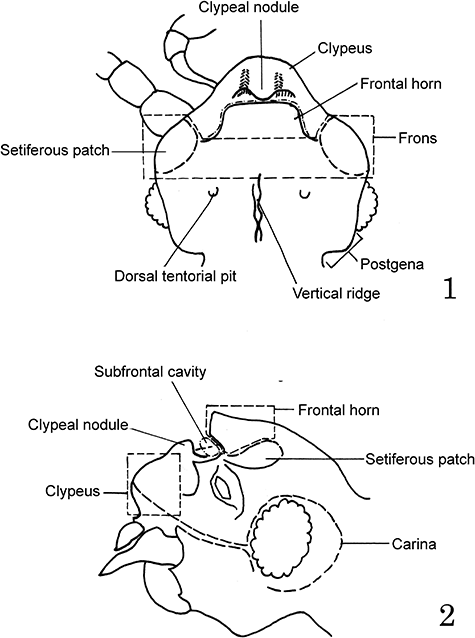
Terminology of cephalic parts. Tenguobythus nasalis sp. nov., male. 1 dorsal view; 2 lateral view.
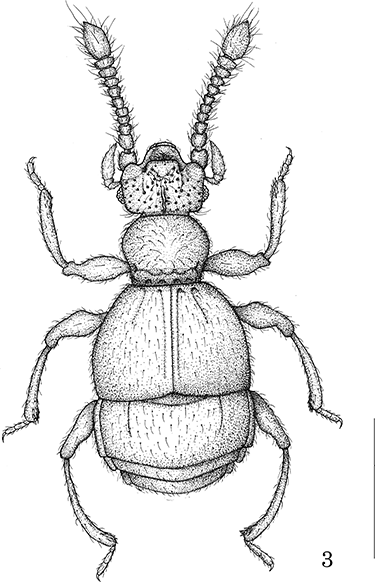
Tenguobythus nasalis sp. nov., habitus of male. Scale line: 0.5 mm.
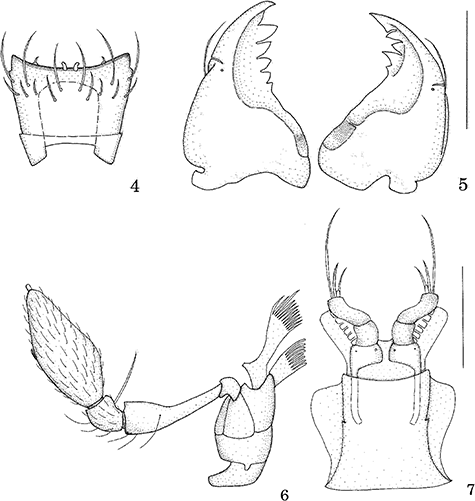
Mouth parts of Tenguobythus nasalis sp. nov., male. 4 labrum; 5 mandibles. Scale line: 0.05 mm; 6 maxilla; 7 labium. Scale line: 0.1 mm.Head almost flat on vertex, wider than long, covered with punctures; clypeus long, clypeal nodule expanded anterodorsally in male, flat in female, strongly carinated on apical margin in both sexes; frons broad, separated from clypeus by small, densely setose area and subfrontal cavity in male; frontal horn originating from anterior part of vertex or posterior part of frons expanded anteriorly in male, lacking in female; lateral parts of frons with a pair of setiferous patches in male, setiferous patches rounded, weakly concave in center, covered with willowy setae or slenderly setose; vertex with a median longitudinal carina, and a pair of dorsal tentorial pits in median part; postgenae broad, angulate in dorsal view. Eyes convex, each composed of 26–48 facets in male, 15–30 in female; genae with carinae around eyes in both sexes. Mouthparts: labrum covered with pubescence, with a pair of spatulate setae at anteromedian part; mandibles each with five to six inner teeth; maxillary palpi small, elongate, densely covered with pubescence, 1st segment short; 2nd elongate, swollen apically; 3rd small and subglobose; 4th the largest, fusiform; labial palpi long and slender. Antennae short, slender; 1st segment thick, cylindrical; 2nd narrower than 1st; 3rd to 8th each granulate; 9th and 10th transverse, 9th narrower than 10th; 11th the largest, fusiform, slightly wider than 10th.

Scanning electron micrograph images of cephalic parts in Tenguobythus nasalis sp. nov., male. 8 dorsal view; 9 ditto, frontal horn enlarged; 10 setiferous patch enlarged; 11 lateral view; 12 ditto, enlarged; 13 anterior view.
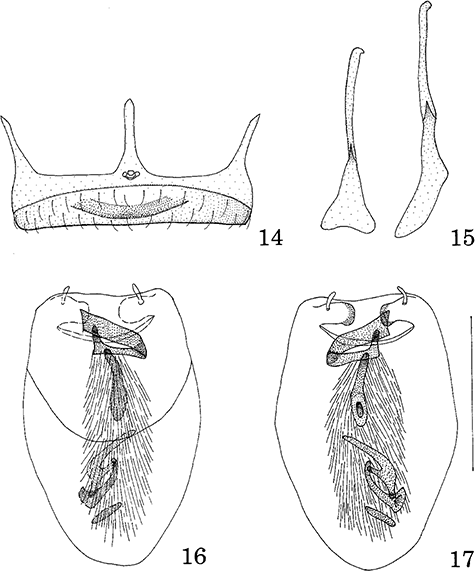
Tenguobythus nasalis sp. nov. 14 8th sternite; 15 9th abdominal tergite; 16 male genitalia of dorsal view; 17 ventral view. Scale line: 0.1 mm.
(Japanese name: Tengu-arizukamushi)
Etymology. The specific name “nasalis” is a Latin adjective meaning “nosed (or large-nosed),” associated with the nose-like frontal horn of this species.
Holotype. ♂ (deposited in NSMT), Jigoku-sawa, Mount Koma-yama, Ôiso-machi, Kanagawa, 6.V.2002, S. A. Paratypes. [Honshû] Miyagi: 1♂ (KPM), Akyû, 15.IX.1981, S. Goshima leg.; Saitama: 1♂4♀ (NSMT), Kakuyama, Ogawa-machi, 30.III.1993, Toshiaki Nambu leg.; 1♀ (NSMT), Kidokoro, Ogawa-machi, 3.III.1993, Toshiaki Nambu leg.; 1♂ (NSMT), Sugaya, Ranzan-machi, 15.VII.1994, K. T.; 1♂ (NSMT), Suwa-no-iri, Shiga, Ranzan-machi, 11.II.2004, S. A.; Chiba: 2♂1♀ (NSMT), Akai-machi, Chiba-shi, 26.IV.1992, Takaaki Takeda leg.; 1♀ (NSMT), Kenmin-no-mori, Funabashi-shi, 7.II.1989, Takaaki Takeda leg.; 2♂3♀ (TUA), Okuno, Ichihara-shi, 16–18.IV.2001, S. Hatsushiba & T. S.; 2♂4♀ (NSMT), Utougi, Futtsu-shi, 3.V.1996, N. A.; 1♀ (NSMT), Mount Kiyosumi, Fudago, Kimitsu-shi, 18.VII.1991, N. A.; 1♂ (NSMT), Mount Kiyosumi, Kaisho, Ootaki-chô, 19.VII.1991, N. A.; 1♂ (NSMT), Mount Takago-yama, Kimitsu-shi, 7.II.1999, T. K.; Tokyo: 1♂. (NSMT), Shizenkyôiku-en, Shirokane-dai, Minato-ku, 28.IX.1999, S. N.; 2♂ (TUA), Minami-ôsawa, Hachiôji-shi, 6–8.XII.1991, T. K.; 1♀ (TUA), Near Tairo-ike, Miyake-jima Is., Izu-shotô Islands, 9.VI.1959, Y. Watanabe leg.; Kanagawa: 1♀ (NSMT), Mount Masugatayama, Kawasaki-shi, 2.II.1985, A. I.; 1♂ (NSMT), same locality, 9.XII.1985, A. I.; 2♂1♀ (NSMT), Miho-cho, Yokohama-shi, 15.XII.1985, A. I.; 1♀ (TUA), Nagatsuda, Yokohama-shi, 4.IV.1994, T. K.; 4♂5♀ (OMNH), Jinmu-ji, Zushi-shi, 6.I.1978, A. Obata leg.; 2♂7♀ (OPU), same locality, 3.I.2001, T. K.; 4♂4♀ (HU), same locality as holotype, 28.III.2001, S. A.; 7♂21♀ (NSMT), same data as holotype; 6♂9♀ (OMNH), Matsuda, 23.IV.1978, Y. Hirano leg.; 1♂2♀ (NSMT), Sengokuhara, Hakone-machi, 25.X.1985, S. N.; Shizuoka: 3♂5♀ (NSMT), Hinata, Shuzenji-chô, 13.I.2002, Y. Tahira leg.; Mie: 1♂1♀ (NSMT), Toyoura-jinja, Kiinagashima-chô, 13.I.1996, H. Yokozeki leg.; Wakayama: 1♂ (NSMT), Ôtaki-jinja, Kawabe-chô, 7.IV.1990, I. Matoba leg.; 1♂ (NSMT), Kohiro Pass, Nakahechi- chô, 17.III.2002, I. Matoba leg. [Shikoku] Ehime: 1♂ (NSMT), Mount Takanawa-san, 5.XII.1992, I. O.; 1♂ (NSMT), Mount Odamiyama, 19.VII.1992, E. Y.; 1♂ (NSMT), same locality, 23.IX.1992, E. Y.; 1♂ (NSMT), same locality, 9.X.1993, I. O.; 1♀ (NSMT), same locality, 10.X.1992, E. Y.; 3♂ (NSMT), same locality, 15.X.1992, E. Y.; 1♂ (EU), Ootani-ike, Iyo-shi, 20.VI.2000, Haruko Ishikawa leg.; Kôchi: 1♂ (NSMT), Mount Hakuô-san, Tosashimizu-shi, 11.II.2001, T. & T. Miyata leg.; 1♀ (NSMT), Kouzaki, Kôchi-shi, 8.VI.2003, T. & T. Miyata leg. [Kyûshû]Ôita: 1♂1♀ (KPM), Hida (Hita-shi?), 20.XI.1979, S. T.; Kumamoto: 1♂ (OMNH), Amakusa-shimo-jima Island, Amakusa-chô, 7.VIII.1977, H. O.; 18♂41♀ (OMNH), Kaname, Hitoyoshi-shi, 15.X.1977, H. O.; 18♂51♀ (OMNH) the north side of Kuma-gawa, Hitoyoshi-shi, 16.X.1977, H. O.; 2♂3♀ (KPM), Hitoyoshi, 16.X.1977, H. O.; Miyazaki: 3♂ (KPM), Kunitomi, 13.III.1980, S. T.; Kagoshima: 3♂4♀ (NSMT), Ishiki-chô, Kagoshima-shi, 24.III.1985, T. Tanabe leg.; 1♂ (NSMT), Aira-chô, 30.I.1985, T. Tanabe leg.
Male. (Fig. 1) BL 1.39–1.53 mm. BW 0.57–0.72 mm. Body dark reddish-brown, tarsi and palpi light brown.
Head (Figs 8–13) almost flat, 1.5 times as wide as long, sparsely covered with small punctures; clypeus long, very weakly convex and densely covered with setae on apical part, clypeal nodule strongly expanded anteriad, densely covered with erect setae in apical part, weakly flattened dorsad, almost glabrous in middle part, convex, trapezoidal in anterior view in basal part, frontal horn short, densely covered with large setae; setiferous patches large, rounded, covered with lanceolate setae; vertex almost flat, with a long vertical ridge; postgenae large, rounded. Eyes convex, each composed of approximately 45 facets. Antennae short; 1st segment cylindrical, as long as wide; 2nd slightly narrower than 1st; 8th slightly wider than 7th; 9th to 10th transverse, 9th 1.6 times as wide as long; 10th 1.2 times as long as 9th, 1.7 times as wide as long; 11th the largest, fusiform, 1.6 times as long as wide.
Pronotum shiny on dorsal surface, 1.2 times as wide as long. Elytra shiny on dorsal surface, 1.3 times as wide as long.
Male genitalia (Figs 16,17) oblong in dorsal view; endophallus consisting of five sclerites and a group of spinules in ventral view; apical sclerites transverse, strongly curved; middle sclerite subconical, weakly curved rightwards; middle two sclerites overlapping the left one; right one subtriangular, arcuate in apical two-thirds; left one subconical, gently curved rightwards; basal sclerites small, slender and elongate; group of spinules elongate.
Female. BL 1.36–1.65 mm; BW 0.6–0.7 mm. Similar to male, but different by the following features: eyes smaller than in male, each composed of 25–30 facets; frons lacking frontal horn.
Distribution. Honshu, Izu-shotô Islands (Miyake-jima Island), Shikoku, Kyûshû.
Remarks. Tenguobythus nasalis is characterized by the small antennal horn covered with slender setae. This species is restricted to the Pacific side of Honshû, Miyake-jima Island, Izu-shotô Islands, Shikoku and Kyûshû.
Tenguobythus rhinoceros sp. nov. (18–23, 24–28)
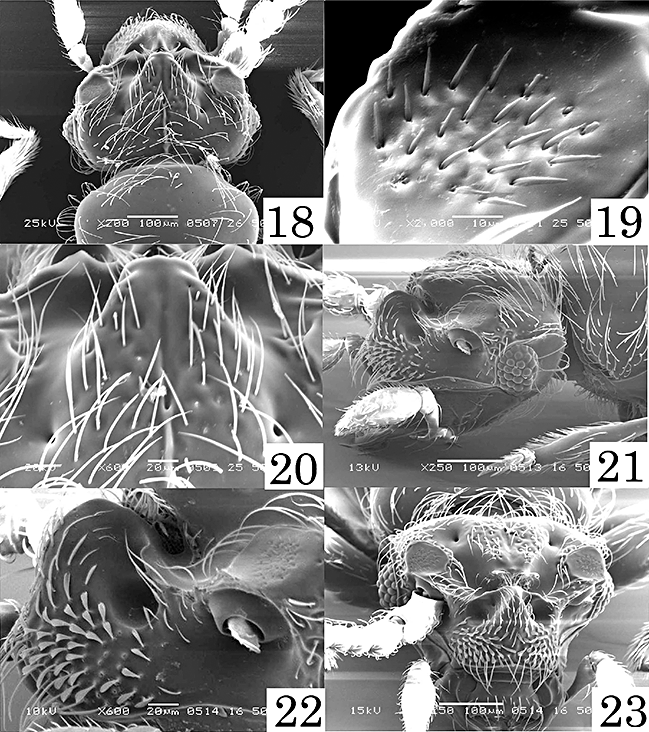
Scanning electron micrograph images of cephalic parts in Tenguobythus rhinoceros sp. nov., male. 18 dorsal view; 19 setiferous patch enlarged; 20 frontal horn enlarged; 21 lateral view; 22 ditto enlarged; 23 anterior view.
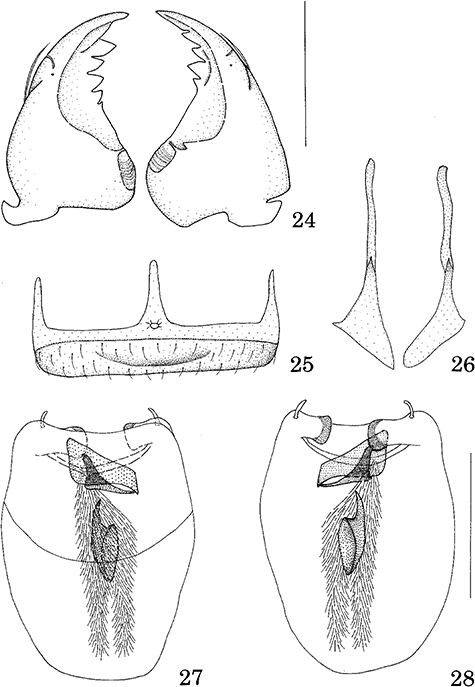
Tenguobythus rhinoceros sp. nov. 24 mandibles. Scale line: 0.05 mm; 25 8th sternite; 26 9th abdominal tergite; 27 male genitalia of dorsal view; 28 ventral view. Scale line: 0.1 mm.
(Japanese name: Amami tengu-arizukamushi)
Etymology. The specific name “rhinoceros” is a Latin noun meaning a horned animal. It is associated with the dorsally projecting clypeus of this species.
Holotype. ♂ (deposited in NSMT), Santarô-tôge, Sumiyô-son, Amami-Ôshima Island, 9.X.2001, T. S. Paratypes. Amami-Ôshima Island: 5♂6♀ (NSMT), Mount Yuwan-dake, 15.V.1996, S. Onoda leg.; 1♂ (NSMT), Akatsuchiyama-kôen, Uken-son, 11.X.2000, T. S.; 2♂ (NSMT), Mount Yuwan-dake, 650 m alt., Uken-son, 12.X.2001, T. S.; 1♂ (NSMT), same data as holotype; 1♀ (OPU), Santarô-tôge, 15.IX.2002, Y. S.; 1♂ (HU), Mount Yui-dake, 26–27.III.2002, H. S.; 1♀ (NSMT), Near Materia-no-taki, Yamato-son, 10.X.2001, T. S.; 2♂ (NSMT), Kinsakubaru, by FIT, 12.V.2006, Y. Shibata leg.
Male. BL 1.29–1.41 mm. BW 0.60–0.67 mm. Body dark reddish-brown, tarsi and palpi light brown.
Head (Figs 18–23) 1.3 times wide as long; clypeus gently arcuate on apical margin, clypeal nodule weakly expanded, strongly convex, sharpened anteriorly in basal part, densely covered with spatulate setae; frontal horn short, densely covered with pubescence, narrowed anteriorly; setiferous patches small, each rounded, covered with slender setae; vertex almost flat, vertical ridge long; postgenae large, gently curved. Eyes convex, each composed of approximately 30 facets. Antennae: 1st segment cylindrical, 1.3 times as long as wide; 2nd slightly narrower than 1st; 9th to 10th transverse, 9th 1.6 times as wide as long; 10th twice as wide as long; 11th the largest, fusiform, 1.4 times as long as wide.
Pronotum shiny on dorsal surface, 1.2 times as wide as long. Elytra densely covered with long pubescence, 1.5 times as wide as long.
Male genitalia (Figs 27,28) elliptical in dorsal view; endophallus consisting of two sclerites and a group of spinules in ventral view; apical sclerites transverse and strongly curved, broadened in dorsal part; middle sclerite subconical, arcuate to right; group of spinules elongate, bifurcate in basal part.
Female. BL 1.37–1.41 mm; BW 0.6 mm. Similar to male, but different in the following features: eyes smaller than in male, each composed of 10–15 facets.
Distribution. Ryûkyûs (Amami-Ôshima Island).
Remarks. Tenguobythus rhinoceros is similar to T. nasalis, but differs in the dorsally projecting clypeus (very weakly convex in T. nasalis), and the apically narrowed frontal horn (squared in T. nasalis).
Tenguobythus pentagonus sp. nov. (29–32, 33–37)
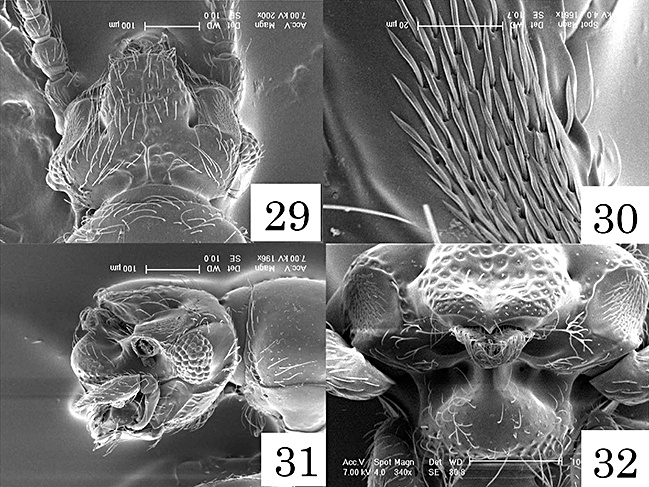
Scanning electron micrograph images of cephalic parts in Tenguobythus pentagonus sp. nov., male. 29 dorsal view; 30 setiferous patch enlarged; 31 lateral view; 32 anterior view.
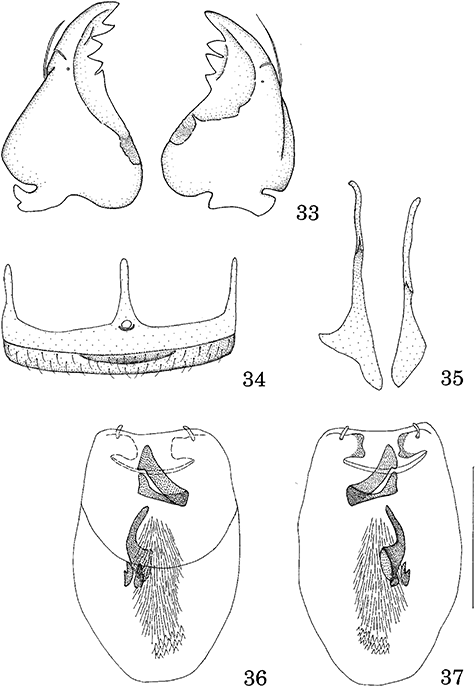
Tenguobythus pentagonus sp. nov. 33 mandibles. Scale line: 0.05 mm; 34 8th sternite; 35 9th abdominal tergite; 36 male genitalia of dorsal view; 37 ventral view. Scale line: 0.1 mm.
(Japanese name:Okinawa tengu-arizukamushi)
Etymology. The specific name “pentagonus” is a Latin adjective meaning “pentagonal,” denoting the pentagonal head of this species.
Holotype. ♂ (deposited in NSMT), Ie-rindô, Okinawa-jima Island, 11–15.III.2001, H. S.. Paratypes. Okinawa-jima Is.: 27♂32♀ (NSMT), same data as holotype; 12♂5♀ (HU), same locality, 23.III.2002, H. S.; 2♂ (NSMT), same locality, 16.III.1985, S. N.; 7♂7♀ (NSMT), same locality, 13.X.1988, S. N.; 1♂ (NSMT), same locality, 27.VI.1999, S. N.; 2♀ (OPU), Mount Nishime-dake, Kunigami-son, 13.IV.1997, Y. S.; 1♀ (OPU), same locality, 19.V.2002, Y. S.; 3♀ (NSMT), Nr. Mount Nishime-dake, 300 m alt., Kunigami-son, 9.IX.2003, S. A.; 2♂ (NSMT), Mount Terukubi-yama, Kunigami-son, 26.II.1992, Dai Haraguchi leg.; 1♂ (NSMT), same locality, 15.IV.1996, H. Hoshina leg.; 4♂1♀ (NSMT), Benoki-dam, Kunigami-son, 1.VIII.1997, K. N.; 1♀ (NSMT), Yamashiro, Ishikawa-shi, 12.VIII.1993, M. Kimura leg.; 1♂1♀ (NSMT), Mount Nekumachiji-dake, Ôgimi-son, 26.VI.1999, S. N.; 2♂ (NSMT), Mount Otoha-dake, VI.1999, S. N.; 1♂ (NSMT), Ôkuni-rindô, Kunigami-son, 22.III.2005, S. N.; 9♂9♀ (NSMT), Mount Yonaha-dake (foot), Kunigami-son, 22.III.2005, S. N.; 1♂1♀ (NSMT), Mount Nago-dake, 11.III.1985, S. N.; 1♂ (OPU), same locality, 7.IX.2003, S. A.; 2♂3♀ (NSMT), same locality, 21.III.2005, S. N.
Male. BL: 1.34–1.62 mm. BW: 0.60–0.70 mm.
Head (Figs 29–32) almost flat on vertex, 1.6 times as wide as long; clypeus sparsely covered with setae, clypeal nodule weakly expanded anteriad, strongly, roundly convex in basal part; frontal horn large, squared in anterior part, slightly shorter than clypeus, covered with pubescence; each setiferous patches very large, weakly angulate in anterior part, densely covered with long lanceolate setae; vertex sparsely covered with large ovoid punctures; postgenae very broad, angulate. Eyes strongly convex, each composed of approximately 50 facets. Antennae weakly broad; 1st segment cylindrical, 1.5 times as long as wide; 2nd 0.7 times as wide as 1st; 9th to 10th each transverse, 9th 1.5 times as wide as long; 10th 1.3 times as long as 9th, 1.9 times as wide as long; 11th the largest, fusiform, 1.5 times as long as wide.
Pronotum smooth and shiny on dorsal surface, 1.3 times as wide as long. Elytra smooth and shiny on dorsal surface, 1.3 times as wide as long.
Male genitalia (Figs 36,37) weakly oblong, in dorsal view; endophallus consisting of four sclerites and a group of spinules; in ventral view; apical sclerite weakly shortened, transverse, strongly curved; group of spinules small and located at center; three middle sclerites at right side; large one subconical, gently curved leftwards; two sclerites on basal part of large one, each small, subconical; teeth patch in basal part.
Female. BL 1.40–1.67 mm; BW 0.6–0.7 mm. Similar to male, but differs by the following characters: very small eyes, each composed of 15–20 facets.
Distribution. Ryûkyûs (Okinawa-jima Island).
Remarks. Tenguobythus pentagonus is similar to T. nasalis, but different in the very long frontal horn covered with pubescence and punctures in the median part (smooth and glabrous in T. nasalis), and the endophallus of male genitalia with a relatively smaller group of teeth.
Tenguobythus yama sp. nov. (38–43, 44–49)
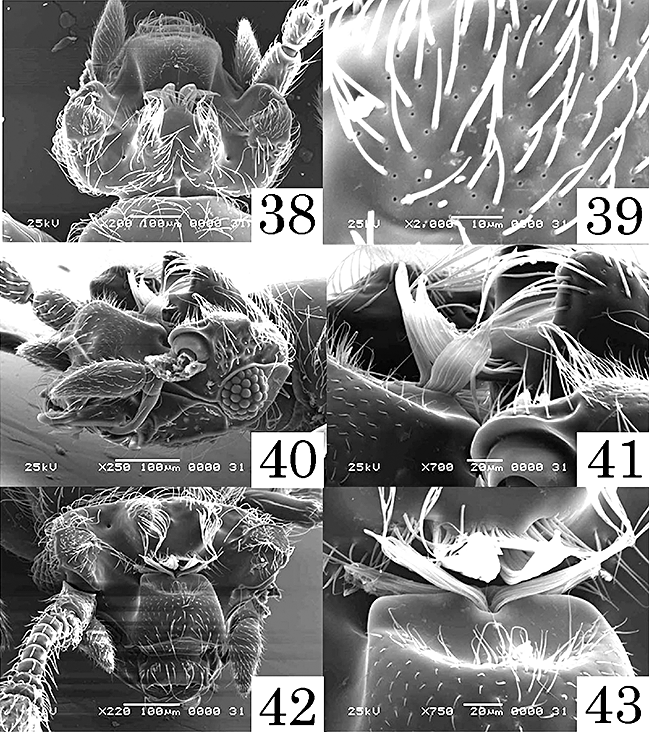
Scanning electron micrograph images of cephalic parts in Tenguobythus yama sp. nov., male. 38 dorsal view; 39 setiferous patch enlarged; 40 lateral view; 41 ditto, enlarged; 42 anterior view; 43 ditto, enlarged.
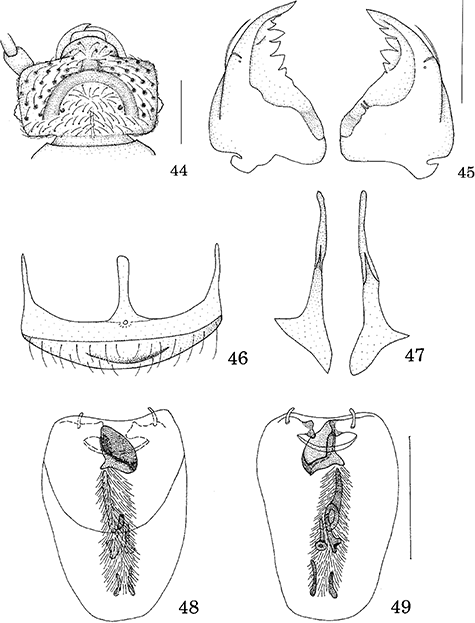
Tenguobythus yama sp. nov. 44 head of female. Scale line: 0.1 mm; 45 mandibles. Scale line: 0.05 mm; 46 8th sternite; 47 9th abdominal tergite; 48 male genitalia of dorsal view; 49 ventral view. Scale line: 0.1 mm.
(Japanese name: Yama tengu-arizukamushi)
Etymology. The species name “yama” is derived from a Japanese noun meaning “mountain,” associated with the strange shape of the male head of this species, which looks like the Chinese character “yama.”
Holotype. ♂ (deposited in NSMT), Mount Yonaha-dake (foot), Kunigami-son, Okinawa-jima Island, 22.III.2005, S. N. Paratypes. Okinawa-jima Island: 2♂ (HU), same locality as holotype, 50 m alt., 20–22.III.2002, H. S.; 1♂ (NSMT), Mount Nago-dake, Nago-shi, 21.III.2005, S. N.; 3♂2♀ (NSMT), same data as holotype.
Male. BL 1.44–1.52 mm. BW 0.65–0.72 mm. Body dark reddish-brown, tarsi and palpi light brown.
Head (Figs 38–43) almost flat, 1.4 times wide as long, densely covered with long pubescence; clypeus long, clypeal nodule rectangularly expanded anteriad in dorsal view, strongly convex in middle part, concave at basal part, densely covered with short setae and minute pores (Fig. 39), with a pair of long broad setae in basal part; frontal horn short, gently sharpened anteriad, with a pair of large trichomes in apical part, concave and smooth at middle, elevated dorsally on lateral margins, densely covered with pubescence; setiferous patches small, each nearly triangular, densely covered with slender setae and secretory pores; vertex almost flat, vertical ridge very short; postgenae large, angulate. Eyes convex, each composed of approximately 40 facets. Antennae slender; 1st segment cylindrical, 1.6 times as long as wide; 2nd slightly slenderer than 1st, 1.8 times as long as wide; 9th to 10th transverse, 9th 1.7 times as wide as long; 10th almost as long as 9th, 2.1 times as wide as long; 11th the largest, fusiform, 1.7 times as long as wide.
Pronotum shiny on dorsal surface, 1.3 times as wide as long. Elytra shiny on dorsal surface, 1.4 times as wide as long.
Male genitalia (Figs 48,49) oblong in dorsal view; endophallus consisting of six sclerites and group of spinules in ventral view; apical sclerite broad and strongly curved; group of spinules slender, elongate; three subconical sclerites in the middle, large one on apical part; two small sclerites on basal part of large one, right one overlapping large one; left one a little shorter than left one; a pair of basal sclerites small, slender and elongate.
Female. (Fig. 44) BL 1.31–1.32 mm; BW 0.60 mm. Similar to male, but differing by the following features: clypeus almost flat; frons with semicircular concavity; eyes smaller than male, each composed of approximately 15 facets.
Distribution. Ryûkyûs (Okinawa-jima Island).
Remarks. Tenguobythus yama is characterized by having the long and dorsally convex clypeus with a pair of very broad setae in the basal part, the very short frontal horn very short with a pair of large trichomes in the apical part, and the setiferous patches densely covered with slender setae and secretory foveae.
Tenguobythus decoratus sp. nov. (50–54, 55–59)
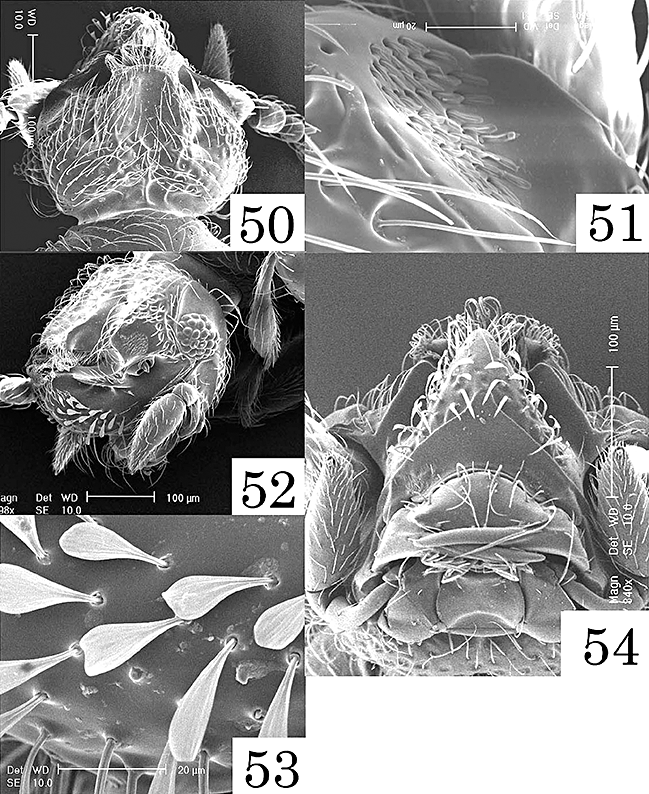
Scanning electron micrograph images of cephalic parts in Tenguobythus decoratus sp. nov., male. 50 dorsal view; 51 setiferous patch enlarged; 52 lateral view; 53 ditto, enlarged; 54 anterior view.
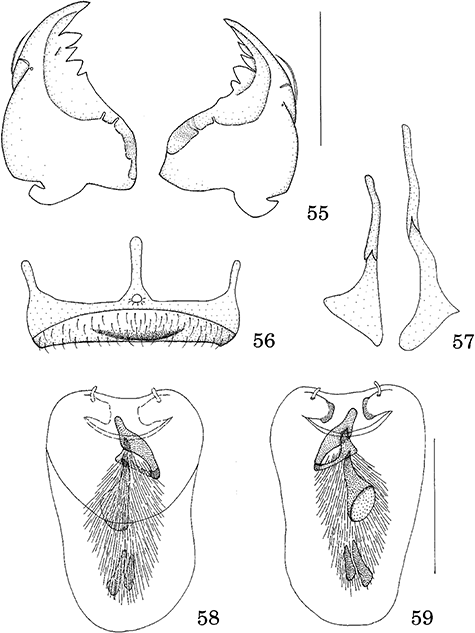
Tenguobythus decoratus sp. nov. 55 mandibles. Scale line: 0.05 mm; 56 8th sternite; 57 9th abdominal tergite; 58 male genitalia of dorsal view; 59 ventral view. Scale line: 0.1 mm.
(Japanese name: Yaeyama-tengu-arizukamushi)
Etymology. The specific name “decoratus” is a Latin adjective meaning “decorated,” derived from the clypeus of this species which is decorated by spatulate setae.
Holotype. ♂ (deposited in NSMT), Mount Omoto-dake, Ishigaki-jima Island, 9.IV.1986, S. N. Paratypes. Ishigaki-jima Island: 42♂75♀ (NSMT), same data as holotype; 6♂23♀ (NSMT), same locality as holotype, 22.III.1984, S. N.; 3♂1♀ (NSMT), same locality as holotype, 13.III.1990, S. Fukui leg.; 3♂2♀ (OPU), same locality as holotype, 17.III.1997, K. T.; 1♂5♀ (NSMT), same locality as holotype, 26–31.VII.1997, K. N.; 11♂16♀ (EU & OPU), same locality as holotype, 3.V.1998, K. T.; 2♂5♀ (OPU), same locality as holotype, 26.XI.1998, T. S.; 7♂14♀ (TUA), same locality as holotype, 26–28.IV.1999, T. S.; 1♂3♀ (NSMT), same locality as holotype, 30.IV.−3.V.1999, S. A.; 14♂15♀ (NSMT), same locality as holotype, 3–7.VI.1999, H. M.; 1♂1♀ (NSMT), same locality as holotype, 24.V.2000, H. M.; 6♂19♀ (TUA), same locality as holotype, 24–26.V.2001, T. S.; 2♂11♀ (TUA), same locality as holotype, 11.VI.2003, H. M.; 1♂ (OMNH), same locality as holotype, 24.III.1975, H. O.; 6♀ (OMNH), same locality as holotype, 20.III.1978, N. A.; 39♂56♀ (NSMT & EU), same locality as holotype, 500 m alt., 19–20.III.2002, H. S.; 82♂82♀ (HU & NSMT), same locality, 250 m alt., 19–20.III.2002, H. S.; 4♀ (NSMT), Yonehara, 10.IV.1986, S. N.; 2♀ (NSMT), same locality, 12.III.1990, S. Fukui leg.; 1♂5♀ (TUA), Mount Buzama-dake, 25.XI.1998, T. S.; 5♂25♀ (EU & OPU), Mount Banna-dake, 28.IV.1999, T. S.; 1♂ (TUA), Takeda-rindô, 1.VI.1999, H. M.; 1♀ (EU), same locality, 6.VI.2003, S. Nagashima leg.; 1♂ (NSMT), Ishigaki-jima Island, 27.V.1996, K. Takahashi leg.; 1♂ (NSMT), Ishigaki-jima Island, by track trap, 28.X.1996, K. Takahashi leg.; 1♂ (OPU), Itona, by light trap, 10.V.1998, Y. S.; 2♂ (HU), Shiramizu, by FIT, 3–6.V.2004, T. Tsuru leg. Iriomote-jima Island: 5♂ (TUA), Komi, 31.V.1999, H. M.; 1♂ (TUA), same locality, 29.V.2000, H. M.; 24♂29♀ (NSMT & HU), same locality, 13–16.III.2002, H. S.; 1♂ (NSMT), Nr. Urauchi-gawa, 30.IV.1998, K. T.; 1♂ (TUA), Shirahama-rindô, 3.V.1999, T. S.; 4♂ (EU), same locality, 3.VI.2003, S. Nagashima leg.; 3♂5♀ (NSMT), Kanpiree, 12–13.IV.1986, S. N.; 1♂ (TUA), Nr. Aira-gawa, by FIT, 19–20.V.2001, T. S. Yonaguni-jima Island: 1♂ (NSMT), Mount Kuburadake, by FIT (NG-3), 15–19.III.2005, S. N.
Male. BL: 1.30–1.49 mm. BW: 0.59–0.61 mm. Body close to that of T. pentagonus in general characters.
Head (Figs 50–54) sparsely covered with large punctures, 1.1 times as wide as long; clypeal nodule strongly convex, angulate dorsally in anterior view (Fig. 54), sparsely covered with spatulate setae; frontal horn long, covered with pubescence at each side; setiferous patches each small, covered with broad setae; vertex densely covered with large punctures, vertical ridge short; postgenae large, angulate. Eyes convex, small, each composed of about 25 facets. Antennae slightly narrow; 1st segment almost as long as wide; 2nd a little narrower than 1st, 1.5 times as long as wide; 9th to 10th each transverse, 9th 1.3 times as wide as 8th, 1.6 times as wide as long; 10th 1.2 times as long as 9th; 1.9 times as wide as long, 11th the largest, fusiform, 1.5 times as long as wide.
Pronotum smooth and shiny on dorsal surface, nearly 1.2 times as wide as long. Elytra smooth and shiny on dorsal surface, 1.5 times as wide as long.
Male genitalia (Figs 58,59) nearly oblong in dorsal view; endophallus consisting of sclerites and a group of spinules; in ventral view, apical sclerites slender and transverse, strongly curved; group of spinules large; middle sclerite large, subconical, thick; two sclerites on basal part, each sclerite conical, right one smaller than left one.
Female. BL 1.35–1.49 mm; BW 0.6 mm. Similar to male, but different as follows: Eyes smaller than in male, each composed of 15–20 facets.
Distribution. Ryûkyûs (Yaeyama-shotô Islands; Ishigaki-jima Islands, Iriomote-jima Island, Yonaguni-jima Island).
Remarks. Tenguobythus decoratus is similar to T. rhinoceros, known from Amami-Ôshima Island, but differs in having the apically sharpened clypeus and the rectangularly projected frontal horn.
DISCUSSION
Tenguobythus belongs to the tribe Iniocyphini, subtribe Natypleurina of the Goniaceritae. The Natypleurina is distinguished from the other subtribe (Iniocyphina) by the following character states: (i) maxillary palpi short, with symmetrical or subconical 4th segment (see 4–7, 18–23, 29–32, 38–43, 50–54); and (ii) elytra lacking subhumeral foveae. The new genus Tenguobythus and the four Asian genera of Natypleurina, Morana (Sharp 1874), Nipponobythus (Jeannel 1958; = Machulkaia, Löbl 1964), Takaorites (Jeannel, 1958; = Bythiotes, Newton & Chandler 1989), Brunomanseria (Löbl & Kurbatov, 2004) are here considered to form a monophyletic group. It is supported by the following apomorphic characters: (i) genae with carina extending from clypeus to eyes; (ii) frons with sexual characters in male; (iii) 4th abdominal segment predominantly large; and (iv) 9th abdominal tergite consisting of a pair of slender sclerites on ventral side.
Brunomanseria is clearly separated from the other genera by the following characters: (i) head almost flat in male; (ii) antennae slender; (iii) pronotum with a well demarcated antebasal transverse sulcus; (iv) elytra each with closely paired discal carinae extending through length; and (v) male genitalia with large parameres.
Tenguobythus and Morana have the following characters in common: (i) gena with a circular carina running around eye in the both sexes (8–13, 18–23, 29–32, 38–43, 50–54); and (ii) head with a deep subfrontal cavity between clypeus and frons in the male (1–2, 8–13, 18–23, 29–32, 38–43, 50–54). However, the following characters occur only in Morana in the male: (i) frontal horn located between antennal tubercles; (ii) head without setiferous patch on frons, but with developed antennal tubercle; (iii) 9th to 11th antennal segments with sexual characters; (iv) pronotal disc smooth in antebasal part; (v) 8th abdominal tergite with several setae on inner side; and (vi) male genitalia with asymmetrical processes in the anterior part.
Tenguobythus, Nipponobythus, and Takaorites share the following characters: (i) frons with setiferous patches in male (8–13, 18–23, 29–32, 38–43, 50–54), (ii) antennal club formed by 9th to 11th antennal segments and lacking sexual characters; and (iii) pronotum with fovea or sulcus in antebasal part. Takaorites is separated from the other two genera by having a unique type of male genitalia (three large apical processes). Tenguobythus is regarded as being most closely related to Nipponobythus in having the frons with a pair of setiferous patches, and similar type of male genitalia consisting of the large and ovoid median lobe with the basal foramen in the apical part, the short parameres, and the endophallus containing several sclerites.
Tenguobythus can be distinguished from other genera by the following character states: (i) head with large frontal horn (8–13, 18–23, 29–32, 38–43, 50–54) from the anterior part of vertex to above the clypeus; (ii) pronotum with three foveae in antebasal part; and (iii) male genitalia (14–17, 24–28, 33–37, 44–49, 55–59) containing three kinds of sclerotized structures: large and strongly curved sclerite in apical part, large group of spinules or denticles at middle, and a few small conical sclerites in the apical to basal part.
ACKNOWLEDGMENTS
We wish to express our hearty thanks to Dr Shun-Ichi Uéno (NSMT) for his continuous guidance and reading of the manuscript. We are also very indebted to the following entomologists for their kind offer of materials: Dr Yasuaki Watanabe (TUA), Mr Yasutoshi Shibata (Tokyo Met.), Dr Shun-Ichiro Naomi (Natural History Museum and Institute, Chiba), Dr Yoshihiro Sawada (Osaka Prefecture), Dr Toshio Kishimoto (Japan Wildlife Research Center), Dr Hideto Hoshina (Fukui University), Dr Hiroshi Sugaya (Naha-shi), Dr Hiroki Mizushima (Tokyo College of Conservation and Civil Engineering), Mr Hideyuki Yokozeki (Mie Prefecture), Mr Yukihiko Hirano (Odawara-shi), Mr Iwao Okamoto (Kure-shi), Mr Takasuke Miyata and Mrs Toshie Miyata (Kôchi Prefecture), Mr Eiji Yamamoto (Ehime Prefecture), Mr Hisashi Ohishi (Kyoto Prefecture), Mr Seiji Morita (Tokyo), Mr Isao Matoba (Wakayama Prefectual Museum of Natural History), Mr Yoshiaki Tahira (Shizuoka-shi), Mr Shigeru Onoda (Kagoshima Prefecture), Mr Masaaki Kimura (Naha-shi), Mr Shûji Fukui (Shimane Prefecture), Mr Katsuyuki Nakata (Kanazawa-shi), Mr Koji Arai (Saitama Prefecture), Ms Haruko Ishikawa (EU), Mr Takashi Shimada (TUA), Mr Tomoyuki Tsuru (HU), and Mr Seidai Nagashima (Hyôgo Prefecture).
Arai also thanks Dr Takayuki Nagashima (TUA) for his kind help in taking the SEM photographs.




